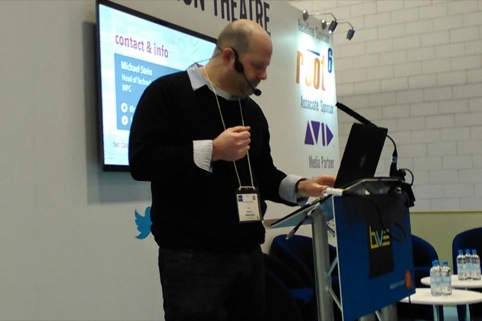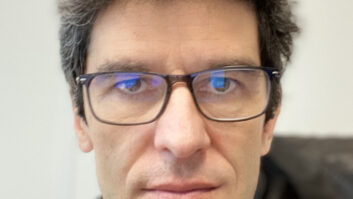
High resolution, sound, colour, frame rate, stereoscopic 3D, interaction, platforms for content consumption: these are the current tech trends identified by Michael Stein, head of technology at MPC, in a keynote session on the first morning of BVE. MPC has been creating visual effects for over 25 years, offering solutions including shoot supervision, 2D compositing, 3D/CG effects, animation, motion design, software development, digital and experiential production, and colour grading, so Stein is well positioned to discuss the effect these have on the post industry.
He honed in on virtual reality (VR) as one technology which has seen recent improvement, citing the success of Oculus Rift, Google Glass and Google Cardboard: “Google had shifted over half a million units of Cardboard by the end of last year,” said Stein. The simplicity of Google Cardboard – combined with a few low-cost accessories, the fold-out smartphone mount creates a virtual reality experience for the user – means it will be “a really interesting thing to watch develop” in the coming months.
Stein pinpointed three companies which he believes will be instrumental in helping create the future of entertainment. Jaunt VR develops hardware, software, tools and applications “to create high-end VR content”. According to Jaunt’s website, the idea for the company only originated in 2013, though despite this Stein mentioned a recently-announced, major deal between Jaunt and Qantas. Samsung Electronics Australia has partnered up with the airline to give the very first in-flight offering of VR entertainment, with a programme featuring a number of preloaded vignettes created by Jaunt. Stein also mentioned London studio Visualise, a small team of specialists “helping to define the language and processes to acquire and create content”. More well known and remaining hugely influential in the VR and immersive experience field is GoPro, producer of high-definition compact cameras, which has “simultaneously cornered and defined a market segment.” The company entered into a partnership with the National Hockey League (NHL) in the US to provide hockey fans new perspectives of the game, including the use of cameras worn by players and officials.
With new methods of content acquisition and consumption, it is necessary for those working in production and post production to adapt to meet the needs of content providers. Stein stressed that we need cameras capable of capturing a higher range of content at higher frame rates. “Custom formats for stereo and VR are needed, and we’re going to need to use more realistic CG renderers, meaning changes need to be made to how we capture.” However, this will result in more data, and “an insane amount of metadata that goes along with it”, for which, he said, we will need more storage.
“We’ll need better tools for compositing and integration,” continued Stein, “and we’ll need to adapt by having better review processes in post production.” This means a new workflow, as “working in VR is not the same as working in anything else.” How viewers consume content has changed significantly over the past decade, and Stein states that this is driving the pipeline. “There are new and different platforms and “we’ll need access to these and to be able to convert content into different platforms as quickly as possible.”
There are new technologies, new content and new methods of delivery and to adapt accordingly, “we need to embrace that future,” concluded Stein.
Post Production Theatre







